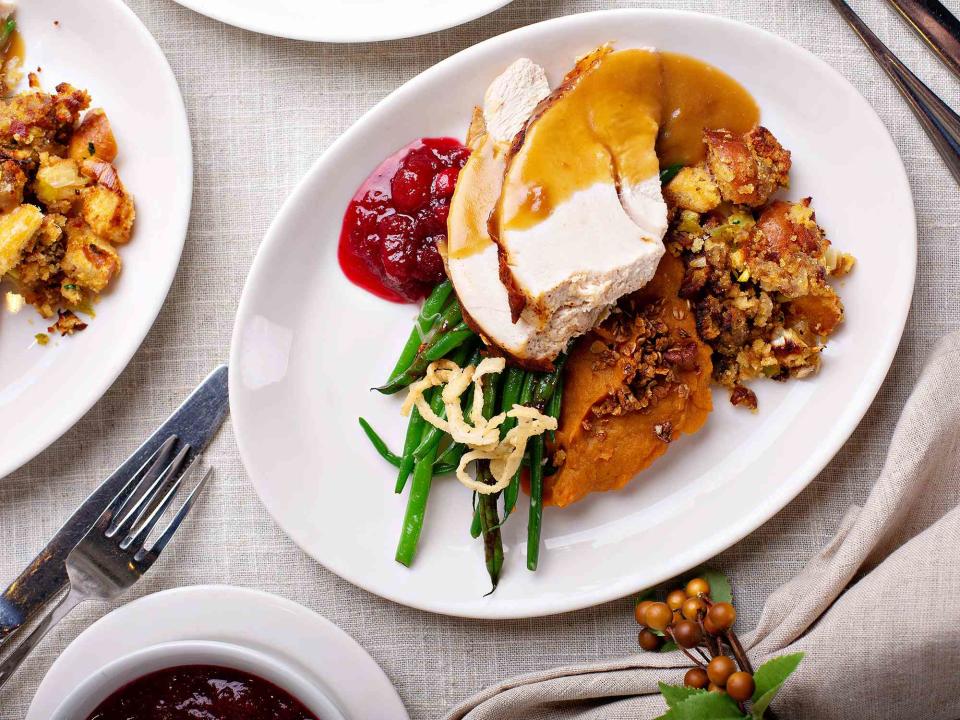Why Do We Eat Turkey on Thanksgiving? The Answer May Surprise You
A different protein used to be the more popular choice.

VeselovaElena/Getty Images
"Why do we eat turkey on Thanksgiving?" is a question many of us ask amid the fixings and trimmings. The answer lies in tradition and festivity mostly, and turkey wasn’t always at the heart of the holiday table. We tapped an expert to help explain how turkey became inextricably associated with Thanksgiving, and here's what we found out.
Meet Our Expert
Ken Albala is a professor of history at the University of the Pacific, specializing in cultural cuisine. His course Food: A Cultural Culinary History is available on DVD from the Great Courses and is free online as a podcast.
Beginnings
When pilgrims from England celebrated their first autumnal feast in the colonies—later coined "the first Thanksgiving"—in 1621, the tablescape in Plymouth, Massachusetts, looked quite different than today's. Records of that multi-day feast are scant, so much of its history is conjecture based on seasonal culinary options, legends, and a few lines written by English colonist Edward Winslow about an obscure fall event.
Venison was likely the protein of choice at that celebration, provided by deer hunters from the Mashpee Wampanoag—an indigenous tribe who lived in the region for roughly 10,000 years before the Mayflower landed. The Wampanoag farmed and foraged, and ate predominantly beans, corn, roots, and berries. The Native Americans and colonists also ate eggs, fish, shellfish, and some meat, like hunted deer and wild birds (perhaps turkeys among them).
A Turn to Turkey
So how did turkey get coupled up with Thanksgiving? “There was a tradition of serving large wildfowl in medieval Europe, especially peacock, which was skinned, cooked, and resewn into its feathers for presentation,” says Albala.
“When turkeys from America and guinea fowl from Africa were introduced [to Europe] in the 17th century, they were served the same way,” Albala continued, so a whole feathered turkey sticking out of a pie was a preparation familiar to colonial settlers. Tart jelly was often served alongside these birds and cranberries, being local to Massachusetts, fit the bill.
While turkey wasn’t likely present in 1621, annual autumnal harvest dinners continued as turkey gained popularity as a source of protein. Indigenous to the area and plentiful, turkeys were larger than chickens, ducks, and geese, making them economical to serve to a crowd. Also, turkeys didn't provide milk like cattle, or edible eggs, so slaughtering one for its considerable meat just made sense to North American homesteaders.
North American turkeys served from the 1700s up to the 1900s were wild fowl, Albala points out. They were scrawnier and quite different from the farmed turkeys we're familiar with, which are often cultivated and raised to be mostly breast meat.
It's Official
In 1863, President Lincoln proclaimed Thanksgiving as an official holiday on the last Thursday of November, and roast turkey was nationally recognized as a celebratory feast. But the lead-up to that designation had less to do with fact and more to do with fiction.
Sarah Josepha Hale’s popular first novel, Northwood: A Tale of New England, described a Thanksgiving feast circa 1827, replete with a large family table topped with roasted turkey, gravy, and vegetables. She subsequently lobbied the President to bestow official status upon Thanksgiving, and is often referred to as "the Godmother of Thanksgiving."
Across the pond, Charles Dickens popularized a prized Christmas turkey in A Christmas Carol, replacing the traditional goose with today's iconic bird. Just like home cooks riff on TikTok trends today, 19th-century hosts eagerly jumped on the turkey train.
Today
A roasted turkey remains America's essential Thanksgiving centerpiece, but the rest of our Thanksgiving table is still evolving. “Although the traditional parts are often there, people add dishes from their own background,” Albala says.
Today's turkey may be traditionally roasted with autumnal herbs, deep-fried in Cajun seasoning, or shellacked like a Peking duck. Alongside you might find Italian sausage or a baked pasta dish, biryani or fried rice, a potato kugel or kimchi, or anything really.
Turkey may remain a Thanksgiving mainstay for the foreseeable future, but what Americans serve as sides is as varied as America’s multicultural makeup. To many, turkey's most important role is as the centerpiece of a meal that serves as a green light that officially starts the holiday season.
For more Real Simple news, make sure to sign up for our newsletter!
Read the original article on Real Simple.

